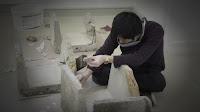台灣檜木.土.金箔.建築化石
匈牙利布達佩斯藝術館,布達佩斯/匈牙利
2010,installation
Taiwan cypress.soil.gold foil.Fossil building
decided by Place
installation view of the exhibition
Taiwan Calling - The Phantom of The Liberty
Műcsarnok Kunsthalle ,Budapest/Hungary,2010
以多瑙河貫穿的布達與佩斯兩座古都為中心,找尋散落在城中教堂周邊的建築碎片,祂們大都遺留在教堂地面上或花園裡,將這些碎片一車車搬運回美術館,並加以清洗乾淨,之後如同檔案一般陳列在貼有金箔的自製書櫃與木桌上。這些承載建築碎片的巨型桌子及書櫃木料來源,是台灣過去殖民時代木造建築的材料,經歷建築拆解再製而成,具備了新的功能與意義。
我決定從聖史帝芬教堂(St. Stephen's Basilica)作為這趟旅行的出發點。
From Buda and Pest, two old cities divided by the Danube, I looked for building fragments scattered around the churches in both cities. They were mostly left on the ground or in the gardens. Then I brought the fragments back to the museum in cart and washed them clean. After that, I placed the fragments in archival fashion on the self-made shelf with gold leaves and a wooden table. The source material for the oversized shelf and table came from the same material used for Taiwanese wooden architecture during colonial period. Through demolish and reproduction, it now takes on new function and meaning.
I decided to begin the journey from St. Stephen’s Basilica.


布達佩斯教堂位置圖(Churchs Location in Budapest)
<木匠和他的花園> (A carpenter and his Garden)
在作品<木匠和他的花園>中邱承宏運用家鄉木造建築的廢料,創造出數個”容器”般的雕塑,他們分別是數張木桌及一面木櫃。這種物件轉換的工程對邱承宏而言,像是進行某種身分轉變的儀式,好比進行了一場鍊金術的過程。之後將這些重製後的雕塑物,與異地的現地物件進行現地的裝置。
邱承宏沿著布達佩斯這倚靠著多瑙河河畔的古老城市周邊,進行了一場近似考古探險的作為,他順著城市中的教堂一路撿拾散落在周邊的建築碎片,這些碎片大多散落在教堂地面或是不起眼的角落邊,他將這些碎片逐步搬運回美術館,清洗乾淨後如同檔案文件般建置在這些他創造的雕塑體之中。
這些岩石碎片像是充斥著各種不同破碎的片語及建築謎題般,它們指涉某種古老的痕跡,這些密碼或圖案符號經由教堂這特殊的地點,揭露某種精神性的生產過程,除了閃爍著某種片斷的意象外,邱承宏藉由這種考古式的探索,重新聚集那些散落在各處的建築碎片,像是塑造出一幅新的風景:一幅被人遺忘的精神物集合體。當過去的宗教與神話其實都已經逐漸的凋謝,留下的是這群看似相同樣貌的碎塊,時代的更迭中逐步同化了它們衰頹的形態,而這群匿名的符號在今天像是變成一片片通往時光隧道的封包。
Le charpentier et son jardin (A carpenter and his Garden)
Dans Le charpentier et son jardin, Chiu Chen-Hung fabrique, à partir de rebuts de bois récupérés dans son village natal, des sculptures ressemblant à des « contenants », dans la composition desquels on parvient à distinguer les tables et l’armoire dont ils sont issus. Pour l’artiste, ce processus de recyclage s’apparente à un cérémonial de transformation analogue au processus de retraitement des métaux. Au fur et à mesure de leur évolution, les objets sculptés à partir de matériaux recyclés sont intégrés dans un agencement comportant des objets décoratifs locaux d’un autre pays, qui finissent par devenir, à leur tour, installations locales.
Chiu Chen-Hung a en effet collecté, à la manière d’un archéologue, des débris de matériaux de construction et autres vestiges trouvés aux abords d’églises en ruine de la vieille ville de Budapest, le long du Danube. Il les a rapportés au musée et, après nettoyage, les a utilisés dans ses œuvres.
Ces débris minéraux sont porteurs de messages fragmentaires qui renvoient à des traces du passé, et de connotations architecturales mal déterminées. Ils sont comme des codes ou des symboles et, parce qu’ils proviennent d’endroits aussi singuliers que des églises, ils révèlent un style architectural particulier. Allant au-delà de la signification historique dont ils sont chargés, l’artiste a, par une démarche quasi archéologique, assemblé des débris épars pour faire émerger un « paysage » nouveau : un ensemble spirituel et matériel oublié. Alors que les religions et les légendes passées disparaissent peu à peu, il nous reste ces débris qui témoignent des changements survenus au fil des siècles et renvoient à des époques révolues. Des symboles d’autrefois deviennent ainsi les nouveaux totems politiques d’aujourd’hui.
附錄
Appendix
----------------------------------------------------------------------------------------------------------
展覽「台灣藝術大學年度傑出創作獎觀摩展」作品
工作桌.土.影像
台灣藝術大學,台北/台灣
2007,installation
a worktable.soil.video
decided by Place
installation view of the exhibition
Remarkable Creation Award of exhibition
National Taiwan University of Art, Taipei/Taiwan,2007



----------------------------------------------------------------------------------------------------------
展覽「Warped Message」作品
工作桌.木梯.石膏.油土.黑土.投影文件
南海藝廊,台北/台灣
2007,installation
a worktable.Wooden ladder.gypsum.modeling clay.black soil.projectors
decided by Place
installation view of the exhibition
Warped Message
Nanhai Gallery, Taipei/Taiwan,2007
〈木匠和他的花園〉通過裝置的形式,重現祖父每天活動場所與物件的關係,這些物件的配置如同劇場般,慢慢將意義滲入這個舞台。它們一部份是來自於祖父過去工作的材料與工具,或是前工廠拆卸下來的建築元件。在今天,這些物件隨著外公年紀日漸增長而有了不同的作用,從過去作為技職的用途,漸漸轉為生活中的陳設或是某種工具物,一直持續到今日,它們因應祖父活動的模式不同而改變原本的功能性。就像是一條從過去到現在持續運作的齒輪,在捲動著歷史的同時,也翻轉出現今存在的某種價值,並為自己下了一個在地式的註腳。今天將它們蒐集起來,在這空間中化身成一座蜿蜒的土丘,一塊塊像是模型般的建築碎片,一頂在烈陽下退色的工作台,試圖把這些封存已久銘刻著過去的傳說編織起來,重新展示另一層的意義。
"A Carpenter and his Garden" is an installation representing the artist’s grandfather’s relationships with his daily life environment and objects.Today they are collected to from winding mounds in the exhibit space. Pieces of construction debris (like models) and a weathered working table under the blazing sun try to weave the legend of the past that are buried a long time age in order to demonstrate a new layer of meaning.







投影文件(部分):



















































沒有留言:
張貼留言